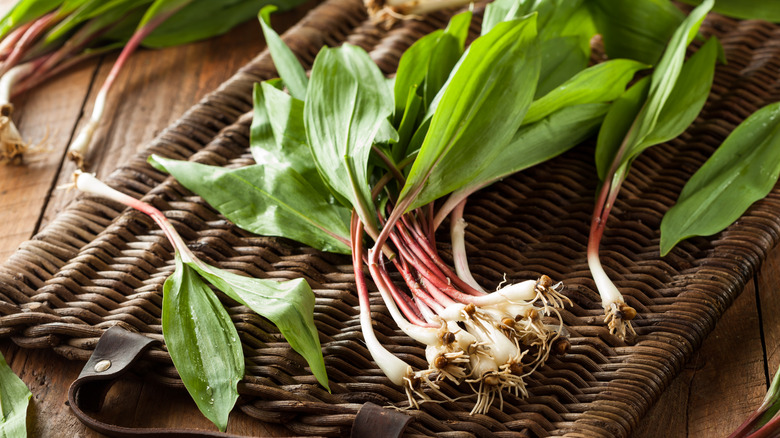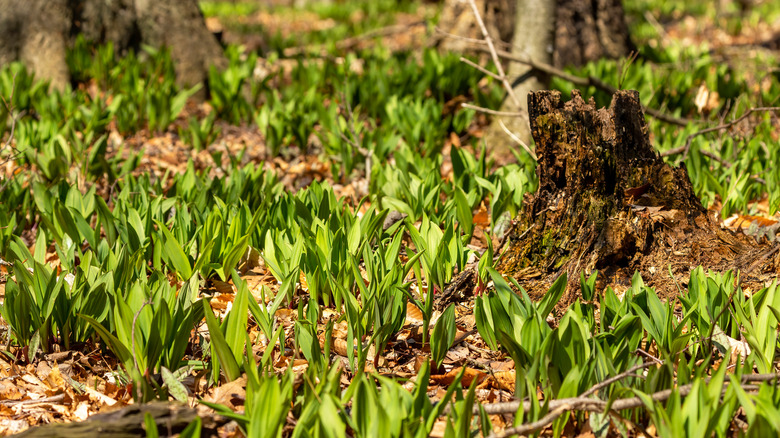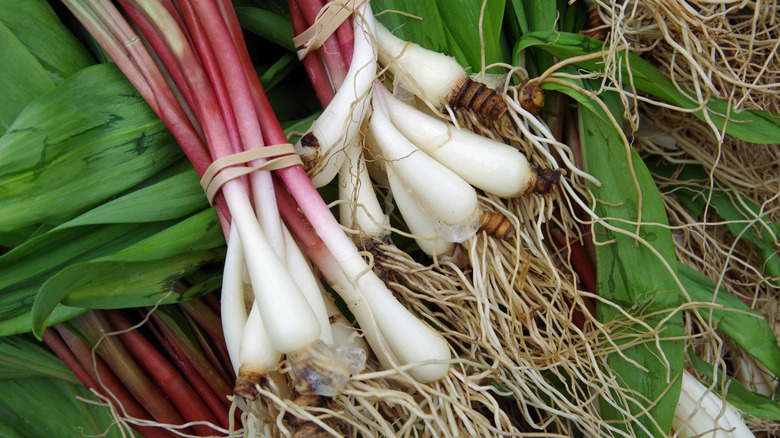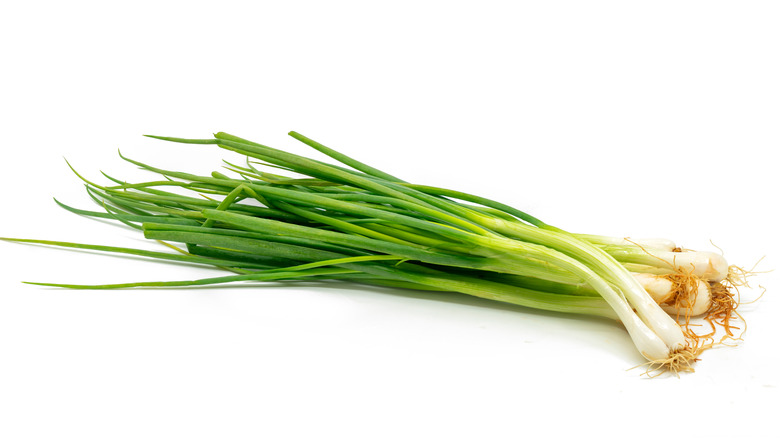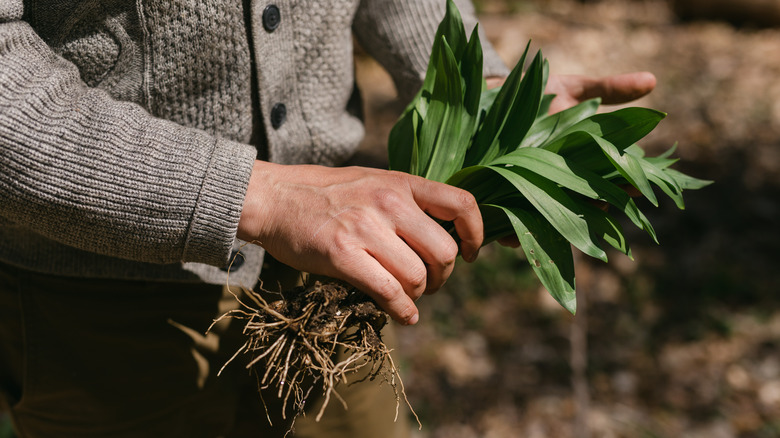Ramps: The Vibrant Spring Vegetable Bursting With Flavor
There's something about ramps that seems to excite even the most novice culinary connoisseur. Whether spotted at the local farmers market or gracing the specials pages of a menu, people tend to gravitate toward, and hone in on, the delicate green wisps.
The foraged favorite has even had its very own festival. Safe to say foodies abound have seemingly fallen in love with the trend-setting, revered ramp. Chefs and home cooks anticipate the season for their new creations while diners keep an eye out on menus.
What makes them so special and beloved? Scarcity, for starters. Their season is brief and their location is limited. From a culinary perspective, their applications are myriad and they have the power to enhance any dish. While modest in appearance and often mistaken for their green onion cousins, the little stalks pack a flavorful, and very fragrant, punch on the palate.
What exactly are ramps, what do they taste like, is there any benefit in eating them, and how do you cook with them?
What are ramps?
Ramps are a member of the Allium family. Other famous members of the club include onions, garlic, leeks, chives, shallots, and scallions. Their official name is Allium tricoccum, though they are often referred to as wild leeks or spring onions. The name ramp comes from "ransom," or the name for wild garlic.
Legend has it, ramps are responsible for giving the city of Chicago its name. The Native Americans had named a river near Lake Michigan after their word for ramp, "shikaakwa," which grew rampant (pun intended) in the area. When French explorers stumbled upon the area, "shikaakwa" may have transformed into "Chicago" in translation.
Ramps grow in eastern North America, ranging from southern Canada to north Georgia, and from the east coast to Minnesota and Missouri. They grow once a year and are found from the first signs of warm weather until the end of spring, making them one of the first wild edibles of the season and a sign that winter is officially over. They flourish in the shade and damp soils of forests.
Ramps are composed of a bulbous root leading to a stem that opens up into broad, flat, smooth green leaves. The stalk is white or often a deep, pinkish purple hue, and sometimes the leaves take on degrees of this shade as well.
What do ramps taste like?
A few words that come to most ramp-lover's (or hater's) mind when describing the taste of the fleeting delicacy are powerful, piquant, pungent, and peppery ... perhaps explaining the seasonal obsession that takes over. They're unlike any other spring vegetable and have the capacity to elevate any plate. While their flavor is unique, it's somewhere of a cross between onions, garlic, and scallions — but with a lot more of that elusive umami. But out of all of their allium family members, they are probably most similar to garlic.
Their smell is distinct — sweet and strong, kind of like an onion, but not. In other words, if there is a bunch hanging out in the crisper drawer of your refrigerator, you'll be reminded every time you open the door. Ramps can be enjoyed raw, but are pretty powerful that way and best enjoyed after a little heat. The leaves have a milder flavor than the stem or bulb, but all parts are edible and serve different purposes in dishes.
How to cook with ramps
For the most part, ramps are interchangeable with scallions, shallots, or leeks in any recipe and you prep them in a similar way. Remove the roots and covering over the bulb and thoroughly rinse and clean them for any dirt.
If you choose to embrace the bite and eat them raw, slice them up thinly and add to a salad or use as a garnish.
If you want to truly embrace the warmer weather and get out the grill, ramps are a perfect pairing with hot coal and a grate. The charring tenderizes them and softens the flavor while enhancing the sweetness. They're also delicious roasted or sautéed in butter or olive oil. They're strong, unique flavor makes them a perfect partner to heartier foods like potatoes, bacon, eggs, and lobster or crab. They also do well with pickling or being turned into a pesto to top your favorite pasta.
However you choose to prepare them, they're sure to add a unique spin to the dish.
Ramps vs. scallions
Scallions hail from Asia whereas ramps are mostly native to North America. Scallions are available year-round while ramps are confined to that very coveted, short window of a fleeting spring season.
Appearance-wise is where many of their similarities lie. Their stalks are similar in length, circumference, and the various shades of dominant green color. The marked difference is in the shape of their leaves — scallions' are narrow, while ramps are wider, flat, and tapered. Ramps may also have the purplish, magenta hue you will never come across in a scallion.
While scallions essentially offer up a milder, subtle onion flavor to a dish, ramps offer that unique hybrid of a handful of allium flavors. Scallions are better suited in dishes where you'd like that hint of onion with a slight sweetness. Ramps are often highlighted in the dish, if not the star of the show, thanks to their loyal fanbase and unique, strong taste. All parts of both scallions and ramps are edible and can be enjoyed cooked or raw.
Nutritional value of ramps
Ramps have been used in a medicinal capacity for hundreds of years. The Native Americans believe ramps to serve as a sort of spring cleansing tonic after the long winter. They were believed to help ward off colds and prevent scurvy and other nutritional deficiencies that may result from the desolate, crop-less winter.
Ramps are high in vitamin C, offering up twice as much as an orange, per Healthline. They are also rich in sulfur compounds which may help prevent cancer and aid in the clotting of blood. Indulging in ramps cyclically will also offer a boost to your overall vegetable intake, and there's a whole host of benefits to that.
A study conducted on rats published in The Journal of Agricultural and Food Chemistry in 2000 confirmed that ramps grown in soil rich in selenium have the potential to reduce the growth of cancerous tumors.
